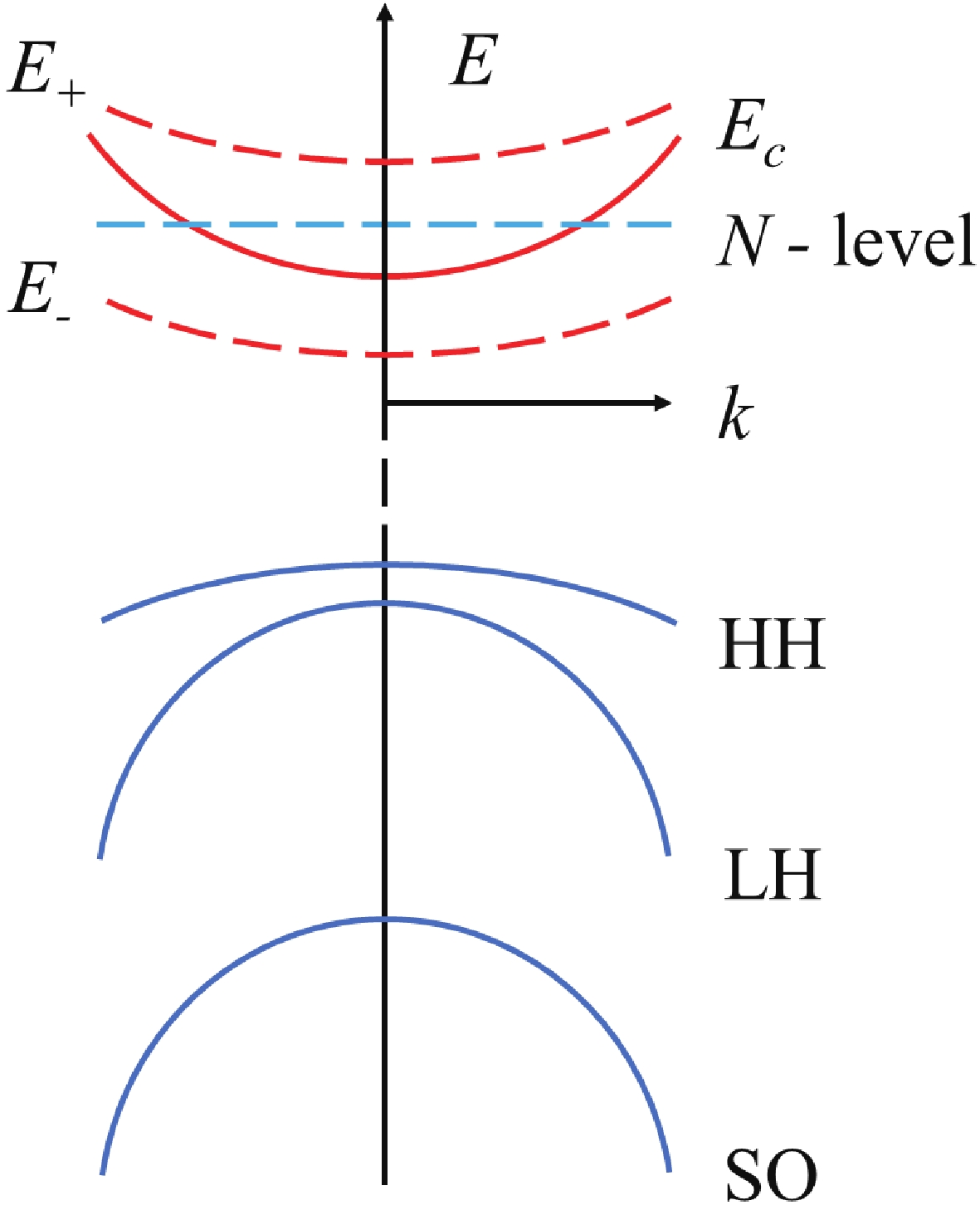| Citation: |
Ratmir Ustimenko, Danila Karaulov, Maxim Vinnichenko, Ilya Norvatov, Andrey Kaveev, Vladimir Fedorov, Ivan Mukhin, Dmitry Firsov. Effect of nitrogen incorporation and surface passivation on photoluminescence properties of InAs-based nanowires[J]. Journal of Semiconductors, 2025, In Press. doi: 10.1088/1674-4926/25030041
****
R Ustimenko, D Karaulov, M Vinnichenko, I Norvatov, A Kaveev, V Fedorov, I Mukhin, and D Firsov, Effect of nitrogen incorporation and surface passivation on photoluminescence properties of InAs-based nanowires[J]. J. Semicond., 2025, accepted doi: 10.1088/1674-4926/25030041
|
Effect of nitrogen incorporation and surface passivation on photoluminescence properties of InAs-based nanowires
DOI: 10.1088/1674-4926/25030041
CSTR: 32376.14.1674-4926.25030041
More Information-
Abstract
InAsN nanowires on InAs stems were obtained using plasma-assisted molecular beam epitaxy on a SiOx/Si (111) substrate. Also, heterostructured InAs/InAsN and InAsN/InP nanowires were grown in the core/shell geometry. In the low-temperature photoluminescence spectra of the grown structures, spectral features are observed that correspond to the polytypic structure of nanowires with a predominance of the wurtzite phase and parasitic islands of the sphalerite phase. It was shown that the interband photoluminescence spectral features of InAsN nanowires experience a red shift relative to the pristine InAs nanowires. The incorporation of nitrogen reduces the bandgap by splitting the conduction band into two subbands. The position of the spectral features in the photoluminescence spectra confirms the formation of a nitride solid solution with a polytypic hexagonal structure, having a concentration of nitrogen atoms of up to 0.7%. Additional passivation of the nanowire surface with InP leads to a decrease in the intensity of nonradiative recombination and an improvement in the photoluminescent response of the nanowires, which makes it possible to detect photoluminescence emission at room temperature. Thus, by changing the composition and morphology of nanowires, it is possible to control their electronic structure, which allows varying the operating range of detectors and mid-IR radiation sources based on them.-
Keywords:
- nanowires,
- photoluminescence,
- InAsN,
- InAs,
- InP,
- core/shell,
- passivation
-
References
[1] Xu T F, Wang H L, Chen X Y, et al. Recent progress on infrared photodetectors based on InAs and InAsSb nanowires. Nanotechnology, 2020, 31(29), 294004 doi: 10.1088/1361-6528/ab8591[2] Guo N, Hu W D, Liao L, et al. Anomalous and highly efficient InAs nanowire phototransistors based on majority carrier transport at room temperature. Adv Mater, 2014, 26(48), 8203 doi: 10.1002/adma.201403664[3] Fang H H, Hu W D. Photogating in low dimensional photodetectors. Adv Sci, 2017, 4(12), 1700323 doi: 10.1002/advs.201700323[4] Wang H L, Wang F, Xu T F, et al. Slowing hot-electron relaxation in mix-phase nanowires for hot-carrier photovoltaics. Nano Lett, 2021, 21(18), 7761 doi: 10.1021/acs.nanolett.1c02725[5] Wang H L, Wang F, Xia H, et al. Direct observation and manipulation of hot electrons at room temperature. Natl Sci Rev, 2020, 8(9), nwaa295[6] Shockley W, Queisser H J. Detailed balance limit of efficiency of p-n junction solar cells. J Appl Phys, 1961, 32(3), 510 doi: 10.1063/1.1736034[7] Shan W, Walukiewicz W, Ager J W, et al. Band anticrossing in GaInNAs alloys. Phys Rev Lett, 1999, 82(6), 1221 doi: 10.1103/PhysRevLett.82.1221[8] Wang S, Kudrawiec R, Chi C, et al. Dilute bismide and nitride alloys for mid-IR optoelectronic devices. Mid-infrared optoelectronics. Amsterdam: Elsevier, 2020, 457[9] Krier A, de la Mare M, Carrington P J, et al. Development of dilute nitride materials for mid-infrared diode lasers. Semicond Sci Technol, 2012, 27(9), 094009 doi: 10.1088/0268-1242/27/9/094009[10] Wu J, Shan W, and Walukiewicz W. Band anticrossing in highly mismatched III-V semiconductor alloys. Semicond Sci Technol, 2002, 17(8), 860 doi: 10.1088/0268-1242/17/8/315[11] Gadret E G, Dias G O, Dacal L C O, et al. Valence-band splitting energies in wurtzite InP nanowires: Photoluminescence spectroscopy and ab initio calculations. Phys Rev B, 2010, 82(12), 125327 doi: 10.1103/PhysRevB.82.125327[12] Faria P E Jr, Campos T, Bastos C M O, et al. Realistic multiband k·p approach from ab initio and spin-orbit coupling effects of InAs and InP in wurtzite phase. Phys Rev B, 2016, 93(23), 235204 doi: 10.1103/PhysRevB.93.235204[13] Gmitra M, and Fabian J. First-principles studies of orbital and spin-orbit properties of GaAs, GaSb, InAs, and InSb zinc-blende and wurtzite semiconductors. Phys Rev B, 2016, 94(16), 165202 doi: 10.1103/PhysRevB.94.165202[14] Hiruma K, Yazawa M, Haraguchi K, et al. GaAs free-standing quantum-size wires. J Appl Phys, 1993, 74(5), 3162 doi: 10.1063/1.354585[15] de la Mare M, Zhuang Q, Krier A, et al. Growth and characterization of InAsN/GaAs dilute nitride semiconductor alloys for the midinfrared spectral range. App Phys Lett, 2009, 95(3), 031110 doi: 10.1063/1.3187534[16] Ibáñez J, Oliva R, De la Mare M, et al. Structural and optical properties of dilute InAsN grown by molecular beam epitaxy. J App Phys, 2010, 108(10), 103504 doi: 10.1063/1.3509149[17] Kaveev A K, Fedorov V V, Pavlov A V, et al. Growth, Crystal structure, and photoluminescent properties of dilute nitride InAsN nanowires on silicon for infrared optoelectronics. ACS Appl Nano Mater, 2024, 7(3), 3458 doi: 10.1021/acsanm.3c06295[18] Sun M H, Joyce H J, Gao Q, et al. Removal of surface states and recovery of band-edge emission in InAs nanowires through surface passivation. Nano Lett, 2012, 12(7), 3378 doi: 10.1021/nl300015w[19] Zanolli Z, Pistol M E, Fröberg L E, et al. Quantum-confinement effects in InAs InP core shell nanowires. J Phys Condens Matter, 2007, 19(29), 295219 doi: 10.1088/0953-8984/19/29/295219[20] Jurczak P, Zhang Y Y, Wu J, et al. Ten-fold enhancement of InAs nanowire photoluminescence emission with an InP passivation layer. Nano Lett, 2017, 17(6), 3629 doi: 10.1021/acs.nanolett.7b00803[21] Varshni Y P. Temperature dependence of the energy gap in semiconductors. Physica, 1967, 34(1), 149 doi: 10.1016/0031-8914(67)90062-6[22] Möller M, de Lima M M Jr, Cantarero A, et al. Optical emission of InAs nanowires. Nanotechnology, 2012, 23(37), 375704 doi: 10.1088/0957-4484/23/37/375704[23] Fedorov V, Vinnichenko M, Ustimenko R, et al. Non-uniformly strained core–shell InAs/InP nanowires for mid-infrared photonic applications. ACS Appl Nano Mater, 2023, 6(7), 5460 doi: 10.1021/acsanm.2c05575[24] Chu J H, Sher A. Device Physics of Narrow Gap Semiconductors. New York: Springer, 2009 -
Supplements
 25030041Supplementary_Information.pdf
25030041Supplementary_Information.pdf

-
Proportional views





 Ratmir Ustimenko received his master's degree in 2021 from Peter the Great St. Petersburg Polytechnic University. He is currently a PhD student under the supervision of Prof. Dmitry Firsov. He is an employee of the scientific laboratories of "Optics of nonequilibrium electrons" and "Epitaxial nanostructures of A3B5 compounds on silicon". His research focused on infrared absorption and emission in GeSi quantum dots and InAs-based nanowires.
Ratmir Ustimenko received his master's degree in 2021 from Peter the Great St. Petersburg Polytechnic University. He is currently a PhD student under the supervision of Prof. Dmitry Firsov. He is an employee of the scientific laboratories of "Optics of nonequilibrium electrons" and "Epitaxial nanostructures of A3B5 compounds on silicon". His research focused on infrared absorption and emission in GeSi quantum dots and InAs-based nanowires. Maxim Vinnichenko Maksim Vinnichenko received his PhD from St. Petersburg State Polytechnic University in Physics and Mathematics on the topic "Processes of recombination and heating of charge carriers in nanostructures with quantum wells" in 2013. He is currently an Associate Professor at Peter the Great St.Petersburg Polytechnic University, Russia. His research focuses on optical phenomena and nonequilibrium charge carriers in semiconductors and nanostructures.
Maxim Vinnichenko Maksim Vinnichenko received his PhD from St. Petersburg State Polytechnic University in Physics and Mathematics on the topic "Processes of recombination and heating of charge carriers in nanostructures with quantum wells" in 2013. He is currently an Associate Professor at Peter the Great St.Petersburg Polytechnic University, Russia. His research focuses on optical phenomena and nonequilibrium charge carriers in semiconductors and nanostructures.
 DownLoad:
DownLoad:





















